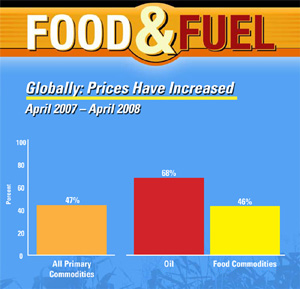 A report out from accounting firm KPMG says that 60 percent of executives believe that consolidation in the renewable energy sector will continue. That’s leading to fears that a bubble may be developing in the solar, wind, and biofuel sectors as bidders compete for assets and send prices sharply higher.
A report out from accounting firm KPMG says that 60 percent of executives believe that consolidation in the renewable energy sector will continue. That’s leading to fears that a bubble may be developing in the solar, wind, and biofuel sectors as bidders compete for assets and send prices sharply higher.
This story from Reuters says many of those same executives expect to jump in as well:
Thirty percent expect to purchase such a company themselves between now and 2010, the survey said.
Earlier this year, oil giant BP (BP.L: Quote, Profile, Research) said it may part-float some of its green energy assets because Chief Executive Tony Hayward said BP’s own market capitalisation did not fully reflect the high market values of such assets.
Fears over climate change have boosted interest in renewable energy and government incentives such as mandates that green sources should account for a portion of the total motor fuel or power markets have helped make the industry more economically viable.
You can read the KPMG report by clicking here.


 The National Biodiesel Board has recognized a group of U.S. Department of Agriculture researchers for finding new uses for natural glycerine, a by-product of biodiesel production, replacing glycerine made from non-renewable petroleum.
The National Biodiesel Board has recognized a group of U.S. Department of Agriculture researchers for finding new uses for natural glycerine, a by-product of biodiesel production, replacing glycerine made from non-renewable petroleum. During a Monday press conference, Secretary Ed Schafer said he had talked to the people who have “initiated these underground things that have been going on” to influence public opinion about ethanol incentives and found that while they understand that higher energy and transportation costs are the driving factor for increased food prices, they think “it’s easier” to target corn and ethanol.
During a Monday press conference, Secretary Ed Schafer said he had talked to the people who have “initiated these underground things that have been going on” to influence public opinion about ethanol incentives and found that while they understand that higher energy and transportation costs are the driving factor for increased food prices, they think “it’s easier” to target corn and ethanol.  I’m taking off for Indianapolis in about an hour. This year, I’ll be handling the Indy 500 on my own. The race isn’t until Sunday, but the
I’m taking off for Indianapolis in about an hour. This year, I’ll be handling the Indy 500 on my own. The race isn’t until Sunday, but the  On Thursday, EPIC will host the Ethanol Summit and Panel Discussion. Guest speakers include Joie Chitwood of the Indianapolis Motorspeedway, Andy Miller, director the the State Department of Agriculture, Eermson Fittipidi, a two-time Indy 500 winner, Brazilian ethanol producer and driver of this year’s felx-fuel Corvette Z06 pace car, Bill Becker, president and CEO of LifeLine Foods – the provider of the E100 racing fuel for the IndyCar Series – and more.
On Thursday, EPIC will host the Ethanol Summit and Panel Discussion. Guest speakers include Joie Chitwood of the Indianapolis Motorspeedway, Andy Miller, director the the State Department of Agriculture, Eermson Fittipidi, a two-time Indy 500 winner, Brazilian ethanol producer and driver of this year’s felx-fuel Corvette Z06 pace car, Bill Becker, president and CEO of LifeLine Foods – the provider of the E100 racing fuel for the IndyCar Series – and more. “We think the time has come for USDA to join in the public conversation about the relationship between food prices and biofuels,” said Agriculture Secretary Ed Schafer. “We want to offer our perspective and what has happened in the marketplace, to share our data and the analysis of what has happened.”
“We think the time has come for USDA to join in the public conversation about the relationship between food prices and biofuels,” said Agriculture Secretary Ed Schafer. “We want to offer our perspective and what has happened in the marketplace, to share our data and the analysis of what has happened.” The Energy Policy Act of 2005 includes provisions enabling the EPA Administrator to grant a full or partial waiver if implementation of the RFS would severely harm the economy or environment of a state, region, or the entire country, or if EPA determines there is inadequate domestic supply of renewable fuel. In consultation with the Departments of Agriculture and Energy, EPA must decide on a waiver request within 90 days of receiving it.
The Energy Policy Act of 2005 includes provisions enabling the EPA Administrator to grant a full or partial waiver if implementation of the RFS would severely harm the economy or environment of a state, region, or the entire country, or if EPA determines there is inadequate domestic supply of renewable fuel. In consultation with the Departments of Agriculture and Energy, EPA must decide on a waiver request within 90 days of receiving it. 
 The senator made the remarks during his first campaign stop in the state that is becoming a leader in wind energy production in
The senator made the remarks during his first campaign stop in the state that is becoming a leader in wind energy production in  Renewable Energy Group (REG) of Ames now runs animal fats in at least four of its seven biodiesel plants in the state, according to Gary Haer, vice president of sales and marketing.
Renewable Energy Group (REG) of Ames now runs animal fats in at least four of its seven biodiesel plants in the state, according to Gary Haer, vice president of sales and marketing. Carlos Riva, president of cellulosic ethanol firm
Carlos Riva, president of cellulosic ethanol firm